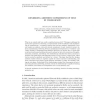Free Online Productivity Tools
i2Speak
i2Symbol
i2OCR
iTex2Img
iWeb2Print
iWeb2Shot
i2Type
iPdf2Split
iPdf2Merge
i2Bopomofo
i2Arabic
i2Style
i2Image
i2PDF
iLatex2Rtf
Sci2ools
IJAIT
2006
2006
Rendering Aesthetic Impressions of Text in Color Space
and renders an abstract color grid artwork reminiscent of early twentieth century abstract expressionism. Following Dewey's psychological interpretation of "aesthetic" and Jung's ontology of fundamental psychological functions, we theorize that a viewer finds an artwork moving and satisfying because it seduces her into rich evocations of thoughts, sensations, intuitions, and feelings. The Aesthetiscope embodies this theory and aims to generate color grids paired with inspiration texts (a word, a poem, or song lyrics), which can be received as aesthetic and artistic by a viewer. The paper describes five Jungian aesthetic readers which are together capable of creative narrative understanding, and three color-logics that employ psycho-semantic principles to render the aesthetic readings in color space. Evaluations of the Aesthetiscope revealed that the program is best at portraying intuition and feeling, and that overall, the Aesthetiscope is capable of creating the ae...
| Added | 12 Dec 2010 |
| Updated | 12 Dec 2010 |
| Type | Journal |
| Year | 2006 |
| Where | IJAIT |
| Authors | Hugo Liu, Pattie Maes |
Comments (0)

